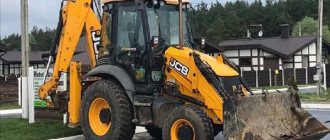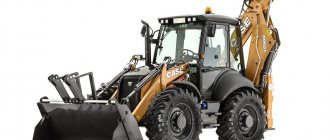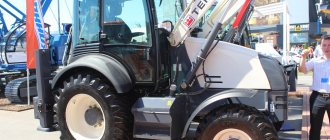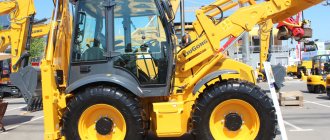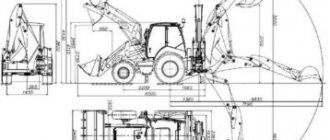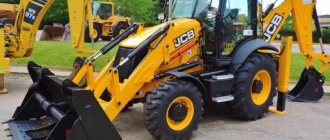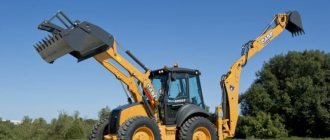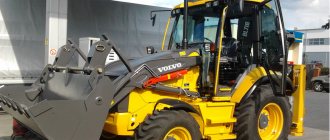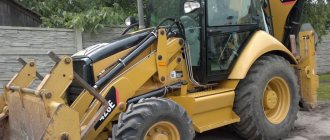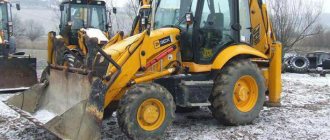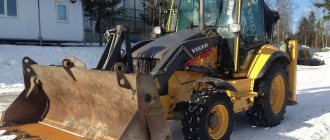422F2
This model's wheeled backhoe loaders have a net power of 52.9 kW, making them the optimal choice for a variety of production and construction tasks. The nominal and maximum operating weight of the machines is 7.529 and 11.086 tons, respectively. In special equipment from this series, Caterpillar has implemented a number of technical innovations in terms of design changes and the introduction of innovative intelligent technologies. Together, this made it possible to increase the productivity of the machines.
The 422F2 engines provide optimal power in a variety of conditions and unsurpassed performance in loading, traversing and backhoeing applications. Excavators of this model are also equipped with a new cabin, which provides the most comfortable conditions for the operator. The level of noise and dust, as well as general fatigue, are reduced. All this helps maintain high operator productivity throughout the entire work shift. The intelligent hydraulic system allows you to adjust the load and distribute work flows according to specific practical needs. And increasing pump performance allows the operator to increase the efficiency of the hydraulic system.
What is a backhoe loader, history of creation
This type of engineering machines appeared in the middle of the last century. As you can easily guess from the name, they appeared by crossing an excavator and a front-end loader. Although, of course, everything happened a little more complicated.
JCB and Case are still arguing for the right to be called the creator of this technology. However, officially, Joseph Cyril Bamford, the founder of JCB, is considered the inventor of the backhoe loader. And that's why.
Excavator bulldozer
The development of technology in the first half of the 20th century made it possible to use a hydraulic drive in controlling an excavator bucket. Hydrofication of equipment made it possible to create mounted excavator equipment, which was installed on an agricultural wheeled tractor. The most suitable place for him was in the back of the car.
The driver's seat is made to swivel for ease of operation of the operator. However, the distribution of the car's weight along the axles has changed, and the steering axle has become almost uncontrollable. Therefore, a straight bulldozer blade was mounted in front. While working with excavator equipment, it served as a counterweight and outrigger. The car turned out to be relatively inexpensive and mobile.
Transformation into a backhoe loader
Improvement of the excavator-bulldozer began immediately after its appearance: alteration of the tractor, modification of attachments. During loading operations, the machine was much inferior to the loaders. Instead of a bulldozer blade, they began to attach loading equipment to parts of JCB machines, but the small swivel wheels of an agricultural tractor with a U-shaped mount could not withstand the loads.
The market niche discovered by Joseph Bamford was recognized by the larger Case firm. She was the first to create a special chassis: a reinforced front axle; frame designed for loads typical for forklifts; modified transmission ratios, and then a hydromechanical gearbox; spacious cabin for reverse control.
Thus was born a new type of earthmoving and transport utility vehicles - backhoe loaders. Today they are produced by dozens of foreign companies. JCB remains one of the leaders. Major manufacturers are Case, Caterpillar, Komatsu, Volvo, Terex, LiuGong, XCMG and others.
In Russia, the evolution of the production of such machines repeats what is described above. The only, unfortunately, sad fact remains that the production of full-fledged backhoe loaders is carried out by only a few companies - ElAZ, RM-Terex (at the Tver Excavator Plant) and KEMZ. And even then, all the machines are licensed developments of foreign companies.
The Belarusian Amkodor is conditionally domestic. The company is also actively developing the niche of backhoe loaders. However, like other domestic manufacturers, they produce attachments that are installed on agricultural tractors, in particular MTZ, YuMZ.
428F2
Machines of this model have a useful power of 71 kW, and their operating weight is 8,425 and 11,086 tons (nominal and maximum, respectively). The second most powerful machine in the new F2 model line, it features a number of advanced, smart innovations and design changes designed to further enhance the performance of Cat excavators.
The cabin of such machines helps create the most comfortable working environment. The seats have adjustments for customization. It is possible to make changes to various functions, which allows you to adapt the machine to specific production tasks and simplify management as much as possible.
The power of the 428F2 excavators is provided by new generation diesel drives. Such engines provide performance when moving machines, carrying out loading operations, using a backhoe and other attachments.
A direct relationship is created between the transmission and the power unit, which is realized through a torque converter with a lock-up clutch. Thanks to this, the average speed increases by 11% and fuel consumption decreases by 16% when moving the excavator along the road.
What work does an excavator perform: purpose, design
Excavators are designed to mechanize the hard work of a digger. With the beginning of the use of earthmoving equipment, earthmoving work has become possible even in low temperature conditions, when it is necessary to work with frozen soil or at night. The work of one unit of excavator equipment and driver replaces several hundred general workers. Every branch of economic activity uses an excavator at least once in its production cycle.
Excavator purpose
The main purpose of an excavator is to loosen soils and rocks. After actual digging, the soil or rock is moved for transportation or formed into an embankment. Depending on the device and operating principles, the main functions for a specific excavator configuration are determined. Excavator equipment is mainly used to perform the following work:
- loosening soil, hard and rocky rocks;
- digging trenches, ditches and forming pits;
- construction of dams, embankments and dumps;
- relief leveling;
- site clearing;
- development of soil under water;
- dismantling of old buildings;
- moving and loading soils and rocks.
All this work is performed at high speed and more efficiently if it were done using manual labor. Among the machines you can find modifications that perform the full cycle of digging, moving and unloading at the same time.
What kind of excavator is needed to work in a particular industry?
In almost any industry, excavator equipment is used at a site where access is possible. Excavators are most widely used in the construction and mining industries, where they perform a full cycle of tasks with almost constant employment. In other industries, excavator equipment is used to perform one-time, seasonal or periodic tasks.
In the agricultural industry, multifunctional backhoe loaders are widely used, which can be used to work in warehouses with bulk cargo, for cleaning areas, for loading hay or straw from fields, and for one-time construction work.
Utility companies use wheeled excavators to operate in urban environments where there is a need to constantly move equipment from one site to another. To work in cramped conditions, mini-excavators are most in demand because they can work in hard-to-reach places.
A separate area is the reclamation and landscaping sector, where excavators are intended to perform complex technological tasks for cleaning reservoirs, for developing canals, and during the transplantation of mature tall plants. For these purposes, special single-bucket crawler excavators have been developed that operate both at and below the level of the working surface.
Excavator equipment is used not only for work on land, but also during work on the surface of the water. For example, during the construction of bridges and dams.
Classification of excavator equipment
Excavator equipment performs approximately the same tasks, which differ in volume, complexity and environmental conditions. To meet the needs of each sector of economic activity, a certain modification of excavators is used. In order to determine which excavator is needed to work in a particular industry, they are usually classified:
- by method of movement;
- by type of chassis;
- by dimensions, load capacity and bucket volume;
- by type of power plant;
- according to the principle of action;
- by type of drive.
Based on the method of movement, a distinction is made between land-based and floating excavators. Based on the type of chassis, there are tracked, wheeled, walking, and rail excavators. Tracked vehicles are distinguished by high maneuverability; they are usually used in areas with complex loose or viscous rocks, as well as for working on difficult terrain with a large degree of slope. Wheeled vehicles are the most versatile and mobile; transportation does not require the use of an additional vehicle.
Based on the dimensions and tonnage of working equipment, it is customary to conventionally divide excavator equipment into mini-excavators, universal and special-purpose. Each group is used according to its capabilities. The more powerful the technology, the narrower the scope of its application and the tasks it performs. For example, heavy single-bucket crawler excavators are used to perform mining tasks.
Based on the type of power plant, diesel, electric, hybrid, gasoline, single- and multi-engine excavators can be distinguished. The operating principle of excavator working units is also one of the indicators of their purpose. The working parts of an excavator can be hydraulic, mechanical, electrical, hydromechanical, etc.
All groups have a number of more narrow differences in power and performance characteristics. Despite such a wide range of distinctive characteristics, the structure and principle of operation of excavators is approximately the same.
Design and principle of operation of an excavator
The design of excavators has fundamental differences, being divided into single-bucket and multi-bucket equipment. Multi-bucket excavators are designed to perform a narrow range of tasks and have limited capabilities when working with soil or other rocks. Single-bucket excavators are designed approximately the same, and their design is based on the following elements:
- the chassis ensures movement around the work area;
- the main frame serves as a connecting element between the chassis and the platform;
- the rotating platform is a supporting element on which the cabin, power and working units are located;
- the driver's cabin includes all excavator controls;
- the engine provides the main energy for the excavator;
- the power transmission drives the working components and assemblies;
- working equipment (boom, bucket) - perform a direct function.
432F2
Like the previous model, this backhoe loader has a net power of 71 kW, but its rated weight is reduced to 8,399 tons. The maximum weight remains unchanged and is 11,086 tons. The 432F2 excavators combine all the advantages of their series. They feature a number of intelligent innovations in terms of control and functionality, and improved design. As a result, this has led to increased productivity, improved ease of use while ensuring efficiency and environmental friendliness.
Power is achieved by equipping the excavators with F-series diesel engines manufactured by Caterpillar. Such drives are reliable, provide high performance with economical consumption of fuel resources. Performance is especially impressive when driving excavators on roads, using backhoes and other equipment.
The 432F2 also features an improved hydraulic system with load-sensing and flow distribution technology. This allows you to direct the flow to the place where it is needed at a particular moment in time. It is also necessary to note the increased comfort of the cabin, ergonomic controls, the presence of anti-vandal protection and built-in keyboards.
Principle of operation
The backhoe loader owes its versatility to the presence of a spacious bucket and its maneuverability. This is the main working part of the machine, which, in turn, can be an excavator or jaw. The first is used in practice as a front blade and loading bucket, and the second performs not only these two functions, but is also used as a lift, grab and scraper.
The capabilities of a backhoe loader can be significantly expanded by installing attachments. These are buckets of various volumes and shapes, drilling rigs, hydraulic hammers, pallet forks, sweeping brushes, clamshell grabs, snow plows. Modern road construction machines additionally use telematics systems that transmit information about the current technical characteristics and location of the equipment in real time.
434F2
Such excavators have a useful power of 65 kW. They have a maximum weight of 11.5 tonnes and a rated weight of 9,257 tonnes. Like previous models, the 434F2 combines technological innovation and design changes to take performance, power, reliability and efficiency to new heights.
Diesel engines enable stable operation of machines in the most difficult conditions. Also, due to the drives, high productivity is ensured during loading operations, driving on roads, and the use of attachments, in particular a backhoe.
Users have the option of purchasing the 434F2 excavator with a telescopic arm, which allows for greater reach and deeper digging. The machine flows are distributed by a hydraulic system that has load adjustment. There is also a rotation shock absorber, which effectively dampens boom vibrations that occur when digging trenches.
Excavator filters are installed in a vertical position, which prevents oil contamination due to spilling of their contents. Lubrication with high-quality, clean materials ensures uninterrupted operation of the hydraulic system, transmission and engine for a long time. Like previous models, the 434F2 excavators feature spacious, comfortable cabs with ergonomic controls.
Few but very promising models
It should be noted that compact equipment is in slightly less demand among our consumers than models of the middle and heavy classes. Apparently, the time of the mini electric class in Russia is still ahead. This is indirectly confirmed by the constant demand for electricity from Belarus, as well as the activation of some leading Russian manufacturers in this direction.
The first e/p, which has considerable advantages over many foreign models, was released under the CHETRA brand. The first-born of the Cheboksary people - CHETRA EPK - weighing about 8 tons is powered by a Perkins engine with a power of 74.7 kW. The all-wheel drive transmission allows you to move using 4 forward gears and the same number of reverse gears, and the main element of the hydraulic system is a dual gear pump with a capacity of 170 l/min. Moreover, the hydraulic system uses 2 distributors: one is designed to control the functions of the loader and is mounted on the frame of the machine, and a very compact second one is installed directly on the handle of the excavator. To control hydraulic valves, electro-hydraulic proportional control using joysticks is used, which is today recognized by experts as the most convenient. The choice of two separate distributors certainly increases the reliability of the hydraulic system.
When using CHETRA EPK as a loader, the operator moves loads weighing up to 3.5 tons, the excavator bucket easily extracts soil from a depth of up to 4.43 m. Moreover, the basic excavator bucket can be replaced in a matter of minutes with, say, a special bucket for digging narrow trenches. To do this, the attachments are mounted on a quick-release ramp, which allows you to install not only various buckets, but also a hydraulic drill, a hydraulic hammer, pallet forks and a variety of grips on the excavator handle.
Just a few years ago, a number of domestic enterprises. such as Zlatex, Lipetsk Traktor, Murommash and others, produced electric vehicles based on wheeled tractors. Today, domestic production of these machines in Russia has essentially ceased.
But there are, of course, positive examples. The Belarusian OJSC AMKODOR produces e/p mod. AMKODOR 702EA and 702EA-01, created on the basis of the Belarus tractor.
Since 2007, JSC Amkodor-Pinsk has been mass-producing its own development of e/p - mod. AMKODOR 702EA. Buyers are also offered a number of modifications to the base model. For example, mod. AMKODOR 702EA-01 is equipped with a mechanical adapter, mod. AMKODOR 702EM-03 is distinguished by the presence of a shiftable digging axis. All models can also be equipped with hydraulic drills, hydraulic hammers, grabs and buckets.
Despite the alarming, to put it mildly, situation with the production of domestic electric power plants, I would like to hope that the government will still pay attention to the development of this sector of Russian mechanical engineering and will not allow our industry to completely switch to using, albeit very reliable, convenient, economical and attractive , but imported backhoe loaders.
444F2
Front-end backhoe loaders of this model have a high net power of 71 kW. Their maximum operating weight is 11.5 tons, and their nominal weight is 8.687 kg. The machines continue the trend of their line - the implementation of innovations and modernization of the design in order to further improve technical and operational properties. The 444F2 delivers high efficiency, impressive performance, and yet is easy to operate and maintain.
Power and performance are provided by diesel engines designed by Caterpillar engineers. The excavators are equipped with a system of improvements to reduce the load on the operator. This feature helps maintain high labor productivity throughout the entire shift and helps ensure safety on the construction site.
The developers also took care of efficiency: the 444F2 excavators reduce fuel costs while maintaining power and productivity. The intelligent hydraulic system effectively and intelligently distributes flows, directing them to areas where they are needed. It is equipped with a high-performance pump, which ensures rational use of resources in the hydraulic system itself. Much attention is paid to security: anti-vandal protection is provided, there are built-in keyboards, and the latest version of the ProductLinkTM system is installed.
Main advantages
The area of application of special equipment largely determines its strengths and weaknesses.
In the city, an excavator can be useful for landscaping and infrastructure maintenance. Performs tasks that powerful industrial equipment is not capable of implementing due to its massiveness, size and clumsiness in a limited space.
With the help of a small backhoe loader, you can easily dig a trench, carry out repairs to a water supply system, perform the functions of a pipe layer, etc. Many models can be equipped with a pipe grabber or a hydraulic hammer to carry out spot repairs of a sidewalk or road. Then, using a bucket, dig a hole and compact everything carefully.
Using a hydraulic hammer on an excavator
The technology also helps in winter, simplifying and speeding up the process of snow removal.
Experts identify 3 key advantages that characterize backhoe loaders. This technique:
- mobile;
- maneuverable;
- multifunctional.
Additionally, it is important to note lower fuel consumption compared to many other types of heavier special equipment.
